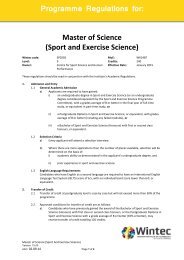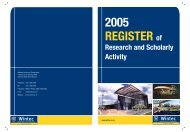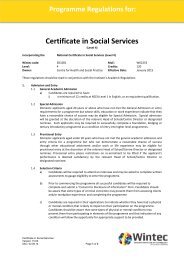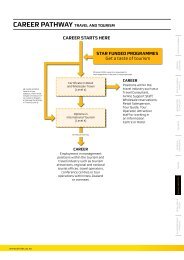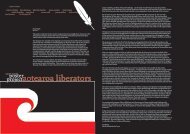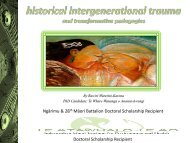Determination of EDTA in Dairy Wastewater and Adjacent Surface ...
Determination of EDTA in Dairy Wastewater and Adjacent Surface ...
Determination of EDTA in Dairy Wastewater and Adjacent Surface ...
You also want an ePaper? Increase the reach of your titles
YUMPU automatically turns print PDFs into web optimized ePapers that Google loves.
PROCEEDINGS OF WORLD ACADEMY OF SCIENCE, ENGINEERING AND TECHNOLOGY VOLUME 34 OCTOBER 2008 ISSN 2070-3740<br />
C. Method Accuracy, Precision <strong>and</strong> Detection Limit<br />
There is no Certificated Reference Material (CRM) available<br />
for <strong>EDTA</strong> <strong>in</strong> waters. The method accuracy was checked us<strong>in</strong>g<br />
the analyte spike recovery, which 100 µg L -1 <strong>of</strong> <strong>EDTA</strong> was<br />
added dairy wastewater samples. The spike recoveries were<br />
between 98 % <strong>and</strong> 102 % (n = 9). Calibration curve<br />
(concentration versus peak area) was obta<strong>in</strong>ed with <strong>EDTA</strong><br />
concentrations rang<strong>in</strong>g from 0 to 750 µg L -1 (0, 10, 50, 100,<br />
200, 500 <strong>and</strong> 750 µg L -1 ) <strong>of</strong> a st<strong>and</strong>ard solution for dairy<br />
wastewater, which were prepared daily from the stock solution<br />
<strong>of</strong> 0.1 g L -1 <strong>of</strong> <strong>EDTA</strong>. Good l<strong>in</strong>earity <strong>and</strong> reproducibility were<br />
observed dur<strong>in</strong>g the experiment. Precision <strong>of</strong> the method was<br />
determ<strong>in</strong>ed by analyz<strong>in</strong>g each sample 12 times (Table I). The<br />
repeatability given as the relative st<strong>and</strong>ard deviation was less<br />
than 1.5 %. The method detection limit (MDL) was calculated<br />
on three times the st<strong>and</strong>ard deviation <strong>of</strong> sample 1 (3*1.43 µg/L),<br />
giv<strong>in</strong>g 5 µg/L <strong>EDTA</strong>.<br />
TABLE I<br />
METHOD REPEATABILITY TEST RESULTS FROM REPLICATE DAIRY<br />
WASTEWATER ANALYSES<br />
Tests<br />
Sample 1<br />
(µgL -1 )<br />
Sample 2<br />
(µgL -1 )<br />
1 107.2 1792.4<br />
2 107.9 1759.3<br />
3 107.1 1758.9<br />
4 107.7 1780.3<br />
5 107.5 1756.3<br />
6 106.9 1737.5<br />
7 106.2 1801.1<br />
8 106.9 1751.0<br />
9 107.7 1753.6<br />
10 104.7 1765.7<br />
11 107.0 1766.8<br />
12 103.0 1759.3<br />
Average 106.7 1765.2<br />
STDEV 1.43 17.97<br />
% RSD 1.34 1.01<br />
D. <strong>EDTA</strong> Analyses <strong>in</strong> <strong>Dairy</strong> Waste Waters<br />
Around 80 dairy waste waters were analyzed, <strong>in</strong>clud<strong>in</strong>g<br />
wastewater from the process<strong>in</strong>g plants, wastewater dur<strong>in</strong>g the<br />
wastewater treatment process<strong>in</strong>g <strong>and</strong> dairy effluent discharg<strong>in</strong>g<br />
<strong>in</strong>to the adjacent river. The concentrations <strong>of</strong> <strong>EDTA</strong> varied<br />
from 72 µg L -1 to 82.7 mg L -1 . A typical chromatogram <strong>of</strong> dairy<br />
waste water is shown <strong>in</strong> Fig. 6. The range <strong>of</strong> <strong>EDTA</strong><br />
concentration (72 ~ 261 µg L -1 ) <strong>of</strong> dairy effluents discharged<br />
<strong>in</strong>to the adjacent river is shown <strong>in</strong> Fig. 7. Data was from 3 days<br />
<strong>in</strong> August, 3 days <strong>in</strong> October <strong>and</strong> 7 days <strong>in</strong> December 2007.<br />
Samples were all 24–hour composite.<br />
Peak height (mv)<br />
<strong>EDTA</strong> peak<br />
Retention time (m<strong>in</strong>)<br />
Fig. 6 Typical chromatogram <strong>of</strong> a dairy wastewater sample<br />
<strong>EDTA</strong> concentration (µg L -1 )<br />
<strong>EDTA</strong> peak<br />
Samples<br />
Fig. 7 Concentrations <strong>of</strong> <strong>EDTA</strong> <strong>in</strong> dairy effluents discharged <strong>in</strong>to<br />
the adjacent river from a large dairy site<br />
E. <strong>Determ<strong>in</strong>ation</strong> <strong>of</strong> <strong>EDTA</strong> <strong>in</strong> <strong>Surface</strong> Water<br />
Forty eight surface water samples, collected <strong>in</strong> August <strong>and</strong><br />
October 2007, were analyzed by the described HPLC method.<br />
A typical chromatogram <strong>of</strong> the surface water sample is shown<br />
<strong>in</strong> Fig. 8. The calibration curve was established daily at the<br />
concentration <strong>of</strong> 0 to 150 µg L -1 (0, 10, 20, 50, 80, 100 <strong>and</strong> 150<br />
µg L -1 ). Duplicate analyses were undertaken every 10 samples<br />
<strong>and</strong> the spike recoveries <strong>of</strong> surface water (50 µg L -1 <strong>EDTA</strong><br />
st<strong>and</strong>ards) every 20 samples as a quality control dur<strong>in</strong>g the<br />
experiment. Averaged duplicate variability was 8.1 % (n=5)<br />
<strong>and</strong> spike recovery varied from 97 – 107% (n=3). The averaged<br />
<strong>EDTA</strong> concentrations, with one st<strong>and</strong>ard deviation, upstream<br />
<strong>and</strong> downstream <strong>of</strong> the dairy effluent discharge are shown <strong>in</strong><br />
Fig. 9. This data represents averaged 12 results at each site. It<br />
can be seen from Fig. 9 that concentrations <strong>of</strong> <strong>EDTA</strong> were<br />
<strong>in</strong>creased downstream 60 m <strong>of</strong> the effluent discharge before the<br />
other stream jo<strong>in</strong>s <strong>in</strong>. The change <strong>of</strong> <strong>EDTA</strong> contents was not<br />
obvious at 10 m downstream as <strong>EDTA</strong> may not be mixed well<br />
with river water yet. The highest concentration <strong>of</strong> <strong>EDTA</strong><br />
analyzed at 60 m downstream was 2.7 µg L -1 . This was well<br />
under the predicted no effect concentration for aquatic<br />
environment – 2.2 mg L -1 [3].<br />
PWASET VOLUME 34 OCTOBER 2008 ISSN 2070-3740 53 © 2008 WASET.ORG




